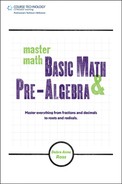Book Description
Get ready to master basic arithmetic subjects, principles, and formulas! Master Math: Basic Math and Pre-Algebra is a comprehensive reference guide that explains and clarifies mathematic principles in a simple, easy-to-follow style and format. Beginning with the most basic fundamental topics and progressing through to the more advanced, Master Math: Basic Math and Pre-Algebra explains the principles and operations of arithmetic, provides step-by-step procedures and solutions, and presents examples and applications. A complete table of contents and a comprehensive index enable you to quickly find specific topics, and the approachable style and format facilitate an understanding of what can be intimidating and tricky skills. Perfect for both students who need some extra help or rusty professionals who want to brush up on their basic math skills, Master Math: Basic Math and Pre-Algebra will help you master everything from fractions and decimals to roots and radicals.
Table of Contents
- Copyright
- Acknowledgments
- About the Author
- Introduction
- 1. Numbers and Their Operations
- 1.1. Digits and the Base Ten System
- 1.2. Whole Numbers
- 1.3. Addition of Whole Numbers
- 1.4. Subtraction of Whole Numbers
- 1.5. Multiplication of Whole Numbers
- 1.6. Division of Whole Numbers
- 1.7. Divisibility, Remainders, Factors, and Multiples
- 1.8. Integers
- 1.9. Even and Odd Integers
- 1.10. Zero
- 1.11. Addition and Subtraction of Negative and Positive Integers
- 1.12. Multiplication and Division of Negative and Positive Integers
- 1.13. The Real Number Line
- 1.14. Absolute Value
- 1.15. Prime Numbers
- 1.16. Rational vs. Irrational Numbers
- 1.17. Complex Numbers
- 1.18. Rounding, Truncating, and Estimating Numbers
- 1.19. Inequalities, >, <, ≥, ≤
- 1.20. Factorial
- 2. Fractions
- 2.1. Definitions
- 2.2. Multiplying Fractions
- 2.3. Adding and Subtracting Fractions with Common Denominators
- 2.4. Adding and Subtracting Fractions with Different Denominators
- 2.5. Dividing Fractions
- 2.6. Reducing Fractions
- 2.7. Complex Fractions, Mixed Numbers, and Improper Fractions
- 2.8. Adding and Subtracting Mixed Numbers
- 2.9. Comparing Fractions: Which is Larger or Smaller?
- 3. Decimals
- 4. Percentages
- 5. Converting Percentages, Fractions, and Decimals
- 6. Ratios, Proportions, and Variation
- 7. Powers and Exponents
- 7.1. Definition of the Exponent or Power
- 7.2. Negative Exponents and Bases
- 7.3. Multiplying Exponential Expressions with the Same Base
- 7.4. Multiplying Exponential Expressions with Different Bases
- 7.5. Dividing Exponential Expressions with the Same Base
- 7.6. Dividing Exponential Expressions with Different Bases
- 7.7. Raising Exponential Expressions to a Power
- 7.8. Distributing Exponents into Parentheses
- 7.9. Addition of Exponential Expressions
- 7.10. Subtraction of Exponential Expressions
- 7.11. Exponential Expressions Involving Fractions
- 8. Logarithms
- 8.1. Definition of the Logarithm
- 8.2. Common (Base Ten) and Natural Logarithm
- 8.3. Solving Equations with Logarithms or Exponents
- 8.4. Exponential Form and Logarithmic Form
- 8.5. Laws of Logarithms: Addition, Subtraction, Multiplication, Division, Power, and Radical
- 8.6. Examples: The Richter Scale, pH, and Radiometric Dating
- 9. Roots and Radicals
- 9.1. Definitions
- 9.2. The Square Root
- 9.3. Estimating Square Roots
- 9.4. The Cubed Root
- 9.5. The Fourth and Fifth Roots
- 9.6. Simplifying Radicals by Factoring
- 9.7. Multiplying Radicals
- 9.8. Dividing Radicals
- 9.9. Radicals Involving Fractions
- 9.10. Rationalizing the Denominator
- 9.11. Addition of Radicals
- 9.12. Subtraction of Radicals
- 10. Important Statistical Quantities
